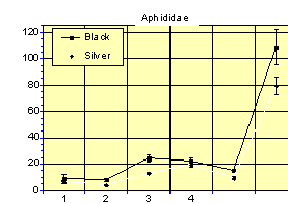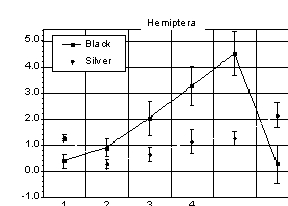Use of Metalized Reflective UV Silver Plastic Mulch for Insect Control in Tomato Production, Knoxville Plant Science Farm, 2000
Roberto Pereira, Brian Leckie, and Bonnie Ownley
Interpretative Summary
An experiment was designed to test the effects of metalized UV reflective silver plastic mulch on insect populations on a tomato crop as compared to the standard black plastic mulch. Yellow sticky cards, replaced weekly from June 8 to July 12, were used to collect flying insects, which were counted and classified. The total number of insects, and insects in the Thysanoptera, Homoptera, Aphididae, Coleoptera, and Hemiptera group were significantly greater in black plastic plots, and Hymenoptera populations were significantly higher in the silver plastic plots. The results confirm that the reflective silver plastic is useful as an insect control measure. Total number of insects are lower in silver plastic plots, and a differential effect on insect groups favors beneficial insects.
Introduction
Colored plastics have been used in tomato crops with the objective of controlling weeds, increasing or decreasing soil temperature, or promoting plant growth and fruit formation. Because of the attraction and repellency of insects by different colors, these colored plastic mulches have also been suggested as insect control measures in different crops. An experiment was designed to test the effects of metalized UV reflective silver plastic mulch on insect populations on a tomato crop, and to evaluate the efficacy of reflective plastic mulch as a preventive pest control method.
Materials and Methods
Two treatments were applied in the field: 1) a metalized UV reflective silver plastic mulch and 2) the standard black plastic mulch. Experimental units consisted of one row of 16 tomato plants separated by 18 in. Within the row. There were 4 blocks (replicates) per treatment arranged in a row. A row of standard-practice tomato (black plastic mulch) separated the reflective plastic treatment from the black plastic treatment (control); another row of tomatoes planted on black plastic separated the reflective plastic plots from an adjacent fallow field. The spacing between rows was 6 ft. and 5 ft were left free of plants between plots within a row.
Tomato seedlings (cv. ‘Mountain Pride’) were produced in the greenhouse from seed treated with Thiran. Seedlings were transplanted to the field on May 8, 2000. Drip irrigation was applied, and there was no attempt to control insects.
During the growing season, yellow sticky cards were used to collect flying insects. Two cards were placed 0.5 to 1 ft. above the tomato plants at two locations inside the plot. Cards were attached to wooden stakes used to tie tomato plants. The first set of cards was placed in the field on May 31, removed on June 8, and then replaced by a new set of cards. Cards were replaced weekly, thereafter, until July 12. All insects on
the cards were counted and classified according to the insect order. Because aphids are considered a prime target for control by reflective plastic, these insects were counted separately from other members of its order (Homoptera).
Due to differences in irrigation regimes, and the occurrence of southern blight (Sclerotium rolfsii), yield data was not collected for these plots. The data for each insect group and for the sum of all insects in the plots were analyzed with JMP and SuperAnova statistical packages. Plastic was used as the main factor and the collection dates were considered as repeated measurements in the analysis. Insect counts were transformed to sqrt(x+0.5) before statistical analysis.
Results and Discussion
The total number of insects was significantly greater on cards placed in black plastic plots than in metalized UV reflective silver plastic plots (Table 1). Lepidoptera, Orthoptera, and Neuroptera were collected only occasionally on the yellow stick cards, and no statistical analysis was conducted on these datra. For Diptera and other insects, no significant differences were observed in the number of insects collected from black plastic or silver plastic plots. Significantly greater number of insects were collected from black plastic plots for the following groups: Thysanoptera, Homoptera, Aphididae, Coleoptera, and Hemiptera. Hymenoptera was the only group of insects collected in significantly greater numbers in the silver plastic plots.
Table 1.Mean number of insects per yellow sticky card placed in a tomato field on plots with either black or silver plastic mulch at the Knoxville Plant Science Farm, 2000.
|
Insect Group |
Black Plastic (Mean + sem) |
Metalized UV Reflective Silver Plastic (Mean + sem) |
|
Diptera |
72.2 + 5.90 |
67.4 + 9.87 |
|
Thysanoptera |
41.4 + 2.76 |
17.5 + 1.46 |
|
Homoptera |
38.9 + 3.57 |
12.7 + 1.32 |
|
Aphididae |
31.2 + 5.59 |
21.8 + 3.98 |
|
Hymenoptera |
27.0 + 2.21 |
57.1 + 6.64 |
|
Coleoptera |
5.4 + 0.66 |
3.6 + 0.50 |
|
Hemiptera |
2.3 + 0.32 |
0.9 + 0.16 |
|
Lepidoptera |
0.2 + 0.07 |
0.4 + 0.22 |
|
Orthoptera |
0.04 + 0.03 |
0.02 + 0.02 |
|
Neuroptera |
0.02 + 0.02 |
0.0 + 0.00 |
|
Other |
0.8 + 0.26 |
40.4 + 0.11 |
|
All Insects |
201.3 + 9.25 |
168.7 + 15.06 |
Numbers in bold are significantly greater than corresponding number in the opposite column at a 0.05 significance level.
The total number of insects collected on sticky cards increased as the season progressed. The highest numbers were found on July 12 (266.4 + 24.75 insects per card) and July 5 (241.5 + 19.51 insects per card). However, populations of different groups followed different patterns throughout the season (Figures 1 - 6). The number of thrips (Thysanoptera) were fairly constant over the season (Figure 1), with a slight increase on July 5. Thrips populations on black plastic were consistently 2X or more than that observed on silver plastic. Homopteran populations were also consistently higher on tomatoes planted on the black plastic than on those on silver plastic (Figure 2). Higher homopteran populations were observed on June 21 and 28. The number of aphids were low during most of the season but jumped to very high numbers on the last sample date (Figure 3). More aphids were found on black plastic plots than on silver plastic through the season. Hymenopteran populations were consistently higher on silver plastic plots than on black plastic plots (Figure 4). Most hymenopterans observed on the sticky cards were alate ants, and the two peaks in the populations observed on June 21 and July 12 may be due to nuptial flights during those weeks. Beetle (Coleoptera) populations were also low during the initial part of the season, peaked on July 12 (Figure 5). Coleopteran populations on black plastic plots were not much higher than those on silver plastic. Hemipteran populations were higher on silver plastic plots at the beginning (June 8) and at the end (July 12) of the season (Figure 6). In mid season, more stink bugs were observed on black plastic plots with a sharp increase of the population in these plots compared to a much lower rate of increase in the silver plastic plots.






Figures 1 - 6 (left to right and top to bottom): Weekly mean number of insect per
yellow sticky card placed in tomato crop on either black or silver reflective plastic: 1) Thysanoptera, 2) Homoptera, 3) Aphididae, 4) Hymenoptera, 5) Coleoptera, and 6) Hemiptera.
The high populations of insects collected on sticky cards placed on black plastic plots in relation to those cards on silver plastic plots confirm the usefulness of the reflective plastic as an insect control measure. Interestingly, the groups of insects that were most repelled by the silver plastic include those that cause most damage to tomatoes and other crops, including thrips, aphids, and other homopterans. The silver plastic appeared attractive to hymenopteran insects. Few pests can be found in this insect order, and many beneficial insects, such as pollinators, parasitoids, and predators, comprise most of hymenopteran insects. Therefore, the use of silver plastic may be beneficial by increasing the number of desirable insects in the field, while numbers of undesirable insects are decreased. Diptera was the most numerous insect order on the sticky cards in both the black and the silver plastic plots. No significantly repellent effect of the silver plastic was observed, but slightly lower populations of these insects occurred on silver plastic plots. The lack of repellent effect against the dipterans may not be of great consequence, because few pests of tomatoes are present in this order, and the order includes several beneficial insects such as parasites and predators of pest insects.
The use of metalized UV reflective silver plastic mulch in tomato crops seems advantageous as an insect control measure. The total number of insects was lower in plots covered with silver reflective plastic. The differential effect on different insect groups seems to favor those orders that contain beneficial insects whereas orders with important pest species are repelled